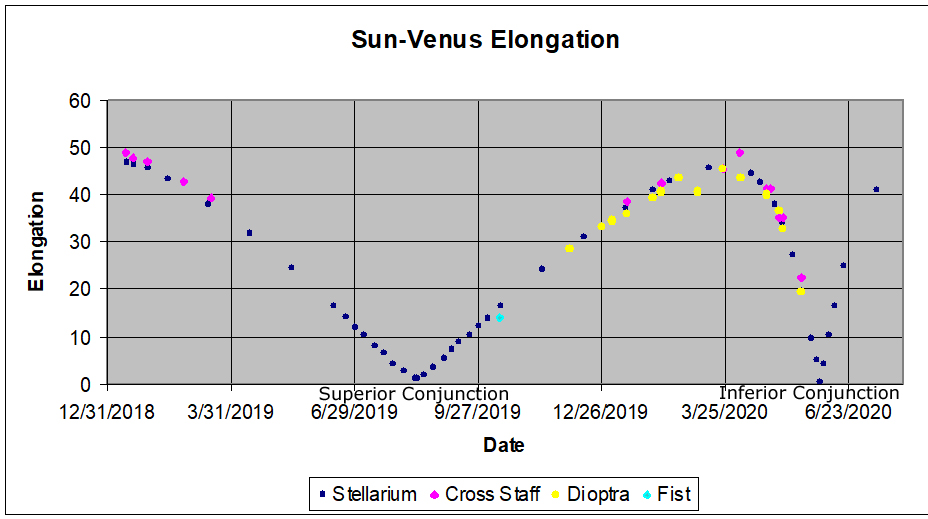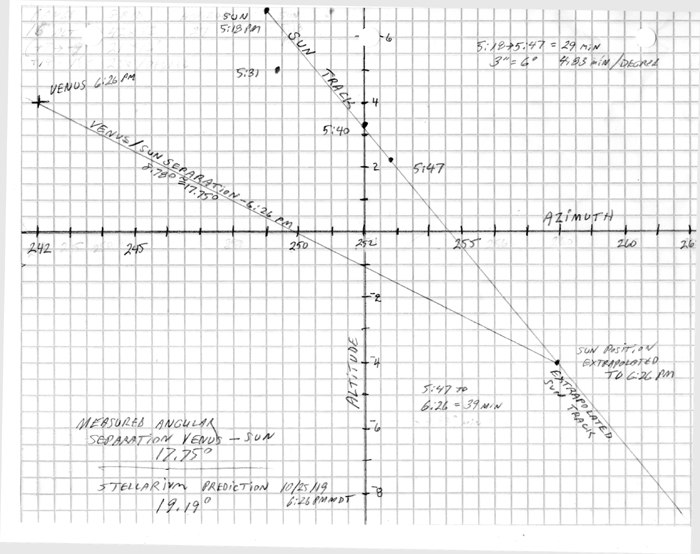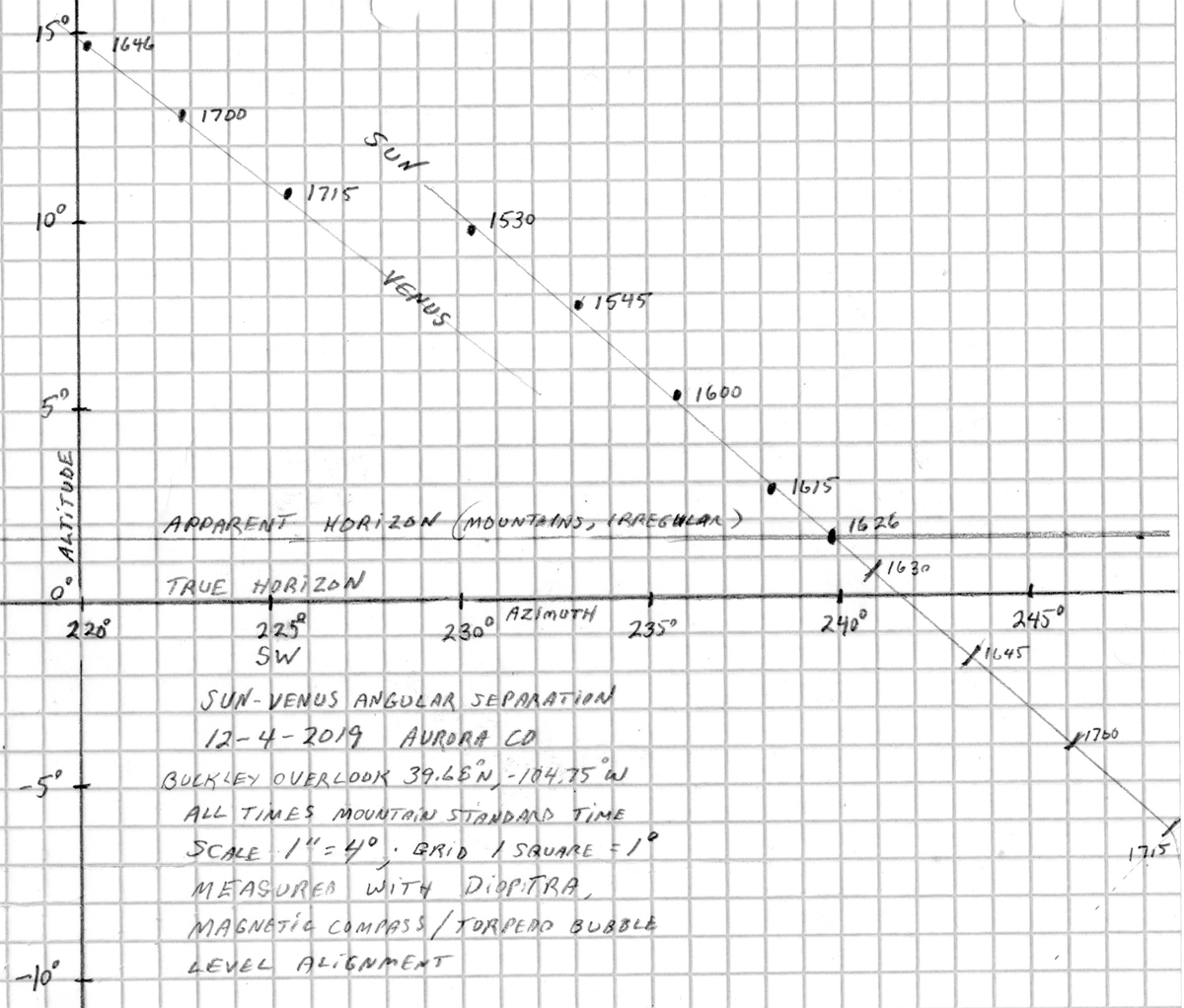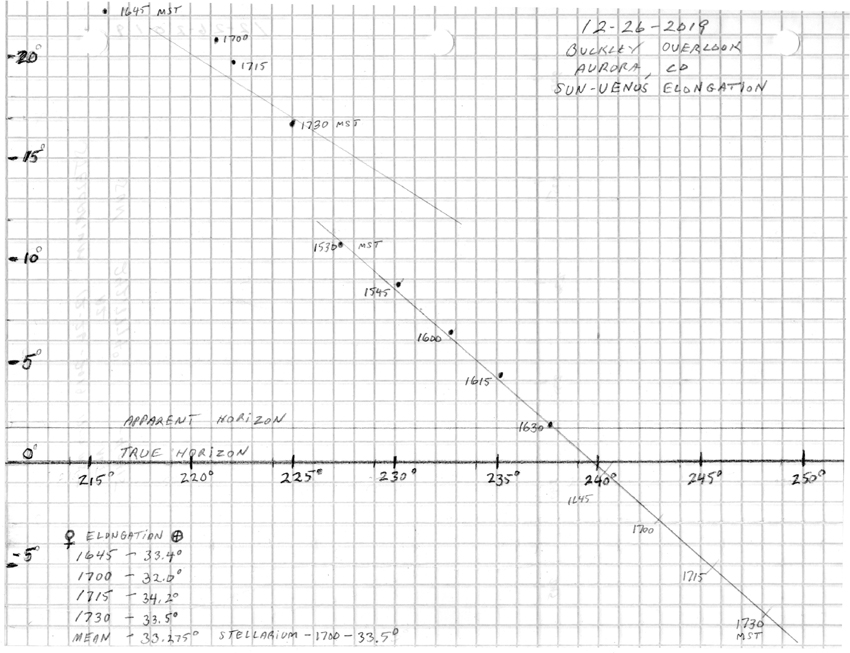
Venus and the Sun
• Venus and the Sun monthly for ½ a cycle from when it first appears in the evening (or morning) sky until it disappears about ten months later. Plan your observation for just after the Sun sets (or before it rises in the morning). Don’t look directly at the Sun. Wait until it just dips below the horizon.
In early November of 2018 Venus first appeared as the "morning star". The Astronomy Before the Telescope program was announced at the end of the year. I made my first measurement on January 14, 2019 when Venus was already a couple of months into the cycle.
Below is an animated .GIF I constructed illustrating the angle of separation between the Sun and Venus as observed from Earth. This shows a six month period from January to June, the first half of 2019. As the animation begins, Venus has already passed its closest approach to Earth and is getting further away. Venus has the inside orbital track, so it circles the Sun faster than the Earth. The apparent elevation increases until its maximum in March, then decreases again until mid Summer when the angle of separation is so small that Venus is lost from visibility in the glare of the Sun. After that Venus passes behind the sun from our perspective and is not visible. Several weeks later Venus emerges as the "morning star".

I used Stellarium to calculate the anticipated angles of separation for 2019-2020. The table below shows the expected values and the angles as measured with the cross staff. The accompanying graph plots the expected and measured values against the date. Calculated values are monthly, around the 14th of each month. Values are measured on the same date, and random additional dates in between.
| DATE | STELLARIUM ANGLE | CROSS STAFF READING |
MEASURED ANGLE | METHOD |
| 01/14/2019 | 46.73o | F 33 | 48.89o | cross staff |
| 01/19/2019 | 46.46o | F 33.8 | 47.92o | " |
| 01/30/2019 | 45.53o | F 34.8 | 46.87o | " |
| 02/14/2019 | 43.26o | hazy | - | " |
| 02/25/2019 | 41.30o | F 38.3 | 42.83o | " |
| 03/14/2019 | 38.23o | snow | - | " |
| 03/17/2019 | 37.78o | E 24.0 | 39.43o | " |
| 04/14/2019 | 31.69o | venus not observable | ||
| 05/14/2019 | 24.55o | venus not observable | ||
| 06/14/2019 | 16.48o | venus not observable | ||
| 07/14/2019 | 8.49o | venus not observable | ||
| 08/14/2019 | 1.27o | superior conjunction | ||
| 09/14/2019 | 8.79o | venus not observable | ||
| 10/14/2019 | 16.49o | 14o | fist & fingers | |
| 10/25/2019 | 19.19 | 17.75 | armillary | |
| 11/14/2019 | 24.03o | |||
| 12/03/2019 | 28.49o | 28.72o | dioptra | |
| 12/14/2019 | 31.12o | |||
| 12/26/2019 | 33.50o | 33.28o | dioptra | |
| 01/03/2020 | 35.25o | 34.57o | dioptra | |
| 01/14/2020 | 37.33o | F43 38.5o | 35.73o | cross staff & dioptra |
| 02/02/2020 | 40.81o | 39.50o | dioptra | |
| 02/14/2020 | 42.92o | |||
| 02/21/2020 | 43.95o | 43.36o | dioptra | |
| 03/06/2020 | 45.30o | 40.65o | dioptra | |
| 03/14/2020 | 45.80o | |||
| 03/24/2020 | 46.15o | F36 45.24o | 45.42o | cross staff
& dioptra maximum elongation |
| 04/06/2020 | F33 48.76o | 43.46o | cross staff & dioptra | |
| 04/14/2020 | 44.48o | |||
| 04/25/2020 | F40 41.1o | 39.97o | cross staff & dioptra | |
| 04/28/2020 | F40.1 41.1o | cross staff | ||
| 05/04/2020 | F47 35.1o | 36.53o | cross staff & dioptra | |
| 05/07/2020 | F47.5 35.1o | 32.88 | cross staff & dioptra | |
| 05/14/2020 | 27.54o | |||
| 05/20/2020 | E43 22.6o | 19.57o | cross staff & dioptra | |
| 06/03/2020 | Inferior Conjunction | |||
| 06/14/2020 | 16.78o | Venus emerges as Morning Star | ||
I generated this graph to chart the progress of my observations. The navy blue points represent the angular separation as predicted by Stellarium. I started with monthly points then added a few more during periods of rapid change. The purple markers represent my observations as measured with the cross staff. The yellow markers are separations calculated from dioptra observations. The sky blue markers are elongations estimated using hands at arms length.
.
Graph of measured and expected Sun-Venus angular separations
Remarks October 2019
In October Venus emerged into view after passing her superior conjunction
(farthest distance from Earth, passing behind the Sun from our perspective on
Earth). Several months past conjunction the angular separation between
Venus and the Sun is finally great enough that Venus becomes visible again, now
as the "Evening Star."
I made my first observation of the "young" Venus on October 14 from Aurora, Colorado. Sunset was at 6:21 pm MDT. Venus finally emerged from the sunset glare nearly 15 minutes later at 6:26 pm. Even though Venus is just past full phase, she is still on the far side of the Sun and so far away from Earth that she is barely visible. Using the "fist and fingers at arms length" method and taking a wild guess as to the Sun's position below the horizon, I estimated the angular separation to be 14o. This is only 2-1/2o off of the Stellarium predicition, suprisingly accurate.
Eleven days later on October 25 I made another observation from the Denver Astronomical Society Edmund G. Kline dark sky site near Deer Trail Colorado. This time I used the armillary sphere described in the Full Moon Rising page. It was still too soon in the cycle for a direct measurment using the cross staff; Venus is not visible until well after sunset. I started by taking altitude and azimuth measurments of the Sun's position and noting the time of each observation. I plotted the path of the Sun on graph paper and extended the path well below the horizon. When Venus finally appeared I measured her altitude and azimuth and noted the time. I then plotted this observation on the graph. I calculated the rate of change of the Sun's position and extrapolated it's position to the time of Venus appearance. I was then able to physically measure the angular separation on the graph. I came up with 17.75o, pretty close to the Stellarium predicted value of 19.19o.
Graph used to determine Sun-Venus angular separation on 10/25/2019

Remarks December 4, 2019
I have completed an early working version of a dioptra which I used for a measurment on December 3 2019. The dioptra is similar in function to the armillary sphere, it is used to measure the altitude and azimuth of objects in the celestial sphere. Venus is still not visible to the naked eye until about 15 minutes after sunset, so a direct measurement with the cross staff is not possible.
I used the same methodology with the dioptra as I did with the armillary. I made four measurements of the Sun's position at 15 minute intervals prior to sunset. I graphed this data set and was able to extrapolate the positions of the Sun at the times of the Venus observations. I made three observations of Venus at 15 minute intervals. I then made a direct measurment on the graph of the separation between the Venus position and the extrapolated Solar position. The three measurments ranged from 28.52o to 28.88o an averaged 28.72o. The Stellarium prediction for sunset on this date is 28.49o, a variance of less than a quarter of a degree.
Below is the graph I used to make these calculations:

Measurements December 26, 2019
Measurements taken at Buckley Overlook, Aurora Colorado using the dioptra. Dioptra azimuth alignment achieved using the landmark/benchmark method. Level achieved with bullseye spirit level.
Venus is getting higher, brighter and farther separated from the Sun. Sunset on the apparent horizon occured at 16:34 MST. Venus was first visible with the unaided eye four minutes later at 16:38 MST, so it is not yet possible to make a direct measurement of the elongation using the cross staff. When direct measurement is possible, I will try making measurements with both the cross staff and the dioptra.
Data
| Time (MST) | Object | Azimutho | Altitudeo |
| 1530 | Sun | 227.3 | 10.8 |
| 1545 | Sun | 220.1 | 8.8 |
| 1600 | Sun | 232.8 | 6.3 |
| 1615 | Sun | 235.2 | 4.2 |
| 1630 | Sun | 237.7 | 1.9 |
| 1645 | Venus | 215.7 | 22.3 |
| 1700 | Venus | 221.2 | 20.9 |
| 1715 | Venus | 222.1 | 19.8 |
| 1730 | Venus | 225.0 | 16.7 |
Graphic Plot

Once again I collected data in 15 minute intervals and plotted the data on the above graph. I constructed a straight line approximating the movement of the Sun, extending the line below the horizon. Using a compass (dividers) I marked off 15 minute hashmarks along the line below the horizon. In this way I was able to extrapolate the approximate positions of the Sun below the horizon after sunset.
Once Venus appeared, I began collecting data, once again at 15 minute intervals. I then plotted these positions on the graph. I could then determine the elongation by directly measuring the distance between points on the graph (standard students quadrille graph paper, 1 square = 1/4").
These determinations were made for the four measurements of Venus. They ranged from 32.0o to 34.2o with a mean value of 33.275o. The elongation predicted by Stellarium for this date at 17:00 is 33.50o.
Mathematical Calculation of Elongation
The above two determinations of angular separation were done by the method of graphic construction. While this method serves well to illustrate the movement of Venus and the Sun, it is prone to procedural error. It is possible to calculate the elongation using simple arithmetic and the Pythagorean right triangle theorem.
In the above case, start by calculating the change in azimuth and altitude of the Sun over the one hour period between 15:30 and 16:30:
Δ AZ = (237.7o - 227.3o) = 10.4o Δ ALT = (10.8o - 1.9o) = 8.9o
The azimuth of the sun is increasing as it sets. Adding the value of Δ AZ to its position at 16:30 will calculate the extrapolated solar azimuth for 17:30. Similarly, the solar altitude (which is decreasing) for 17:30 can be determined:
AZ: 237.7o + 10.4o = 248.1o ALT: 1.9o - 8.9o = -7.0o
The position of Venus at 17:30 has already been determined by direct measurement with the dioptra. The difference in azimuth and altitude can be calculated by simple subtraction:
Δ AZsun-venus = AZsun - AZvenus
Δ ALTsun-venus = ALTvenus - ALTsun
ΔAZsun-venus = 248.1o - 225.0o = 23.1o
Δ ALTsun-venus = 16.7o -
(-7.0o) = 23.7o
Using these values as the legs of a right triangle, the hypoteneuse can be calculated. The derived value is the calculated angular separation between the Sun and Venus.
(ΔAZsun-venus)2 + (ΔALTsun-venus)2
= angular separation2
23.12 + 23.72 = angular separation2
533.61 + 561.69 = angular separation2
1095.3 = angular separation2
√1095.3 = angular separation
33.095 = angular separation
The mathematically derived value of 33.095o is in close agreement with the graphically constructed value of 33.275o and the Stellarium predicted value of 33.50o.
Future measurements of angular separation for this activity will use the mathematical method. I will publish data tables but no more graph images. When Venus is finally bright enough for direct measurement at sunset, I will make those measurements with the cross staff in addition to the dioptra. As Venus approaches inferior conjunction it becomes quite bright. I expect I will be able to make direct (cross staff) measurements much closer to the Sun than I was able to do last Spring when Venus approached superior conjunction and was quite distant and dim.
January 3, 2020
Observations on this date made at Buckley Overlook. I used the dioptra levelled with the bullseye spirit level and aligned with the previously established north-south landmark and benchmark.
Data
| Time (MST) | Object | Azimutho | Altitudeo |
| 1530 | Sun | 227.4 | 12.3 |
| 1545 | Sun | 230.0 | 10.2 |
| 1600 | Sun | 232.6 | 8.1 |
| 1615 | Sun | 235.1 | 5.7 |
| 1630 | Sun | 237.8 | 3.2 |
| 1645 | Venus | 215.8 | 26.7 |
| 1700 | Venus | 219.1 | 24.8 |
| 1715 | Venus | 222.7 | 22.6 |
| 1730 | Venus | 226.0 | 20.6 |
Calculations
In one hour between 15:30 and 16:30 the Sun's apparent motion was +10.4o
in azimuth and -9.1o in altitude. Extrapolating these measurements to
17:30, the Sun's predicted position would be 248.2o Az / -5.9o
Alt. This differs from the observed position of Venus at 17:30 by 22.2o
in azimuth and 26.5o in altitude. Using the previously
described formula [ (ΔAZsun-venus)2 + (ΔALTsun-venus)2
= angular separation2 ] the angular separation is
calculated to be 34.6o. The Stellarium prediction is 35.2o.
January 14 2020
Subsequent observation reports will be more abbreviated showing data, results, and stellarium prediction. I will no longer show the calculations. Above methods are used for calculations. Unusual circumstances may be noted.
| Time (MST) | Object | Azimutho | Altitudeo |
| 1545 | Sun | 229.9 | 11.2 |
| 1615 | Sun | 235.1 | 6.8 |
| 1645 | Sun | 240.0 | 2.2 |
| 1715 | Venus | 222.8 | 27.1 |
| 1745 | Venus | 229.8 | 22.6 |
Elongation calculated at 35.73o. Stellarium prediction 37.33o. Venus is showing increasing elongation and significant brightening. Direct measurments of elongation with the cross staff are once again possible. The cross staff reading at observed sunset (16:51) was scale F - 43cm. Using the cross staff conversion chart, this corresponds to 38.46o. Observations made at DAS Kline dark sky site. Dioptra used.
February 2, 2020
Beautiful clear evening after an unusually warm day. Even Superbowl LIV couldn't stop me from shooting the Sun and Venus. Obsevations from back yard. Dioptra used. No cross staff measurements this time.
| Time (MST) | Object | Azimutho | Altitudeo |
| 15:55 | Sun | 228.8 | 14.3 |
| 16:55 | Sun | 239.1 | 5.2 |
| 17:55 | Venus | 231.1 | 30.1 |
Elongation calculated as 39.50o. Stellarium prediction 40.81o.
February 8, 2020
Observations from Buckley Overlook.
| Time (MST) | Object | Azimutho | Altitudeo |
| 16:15 | Sun | 239.0 | 12.9 |
| 17:15 | Sun | 249.1 | 2.8 |
| 18:15 | Venus | 242.1 | 29.7 |
Elongation calculated as 40.76o.
Stellarium prediction 41.97o.
Direct measurement near sunset (18:22) with cross staff:
scale F, 39cm = 42.08o.
Mercury observed at 18:02. Alt=250.1o/
Az=10.7o. Stellarium prediction 250.5855o / 9.7947o.
February 21, 2020
Observations from Buckley Overlook
| Time (MST) | Object | Azimutho | Altitudeo |
| 16:30 | Sun | 244.8 | 13.2 |
| 17:30 | Sun | 254.8 | 2.4 |
| 18:30 | Venus | 250.7 | 32.6 |
Elongation calculated as 43.36o. Stellarium prediction 43.95o
March 6, 2020
Observations from back yard. I set up in a hurry that evening, got less than 30 minutes solar tracking. The result is the largest error I have produced.
| Time (MST) | Object | Azimutho | Altitudeo |
| 17:16 | Sun | 254.4 | 7.7 |
| 17:39 | Sun | 258.3 | 4.9 |
| 18:46 | Venus | 256.7 | 33.9 |
Elongation calculated as 40.65o. Stellarium prediction 45.3o.
March 24, 2020
This day marks the greatest elongation between the Sun and Venus. After this day, Venus begins to gradually appear closer to the sun. Observations made in back yard. Time changed to Daylight Savings time since previous observation.
| Time (MDT) | Object | Azimutho | Altitudeo |
| 16:00 | Sun | 235.6 | 35.7 |
| 19:00 | Sun | 268.4 | 3.3 |
| 20:00 | Venus | 266.6 | 36.1 |
Elongation calculated as 45.42o. Direct measurment also made with cross staff. The Sun was already below the horizon for several minutes when Venus finally appeared, so estimated its position. Cross staff read 36cm on scale F, translating to a measurment of 45.24o. Stelllaruium prediction 46.15o. Both measurements within one degree of actual position.
April 6, 2020
Observations from back yard with both dioptra and cross staff. Venus has now passed her greatest Eastern Elongation and is apparently moving closer to the sun.
| Time (MDT) | Object | Azimutho | Altitudeo |
| 17:00 | Sun | 254.3 | 27.9 |
| 18:00 | Sun | 264.6 | 16.8 |
| 19:00 | Sun | 274.3 | 6.4 |
| 20:00 | Venus | 272.1 | 37.8 |
Elongation calculated as 43.46o. Direct
measurement with cross staff: 48.76o (scale F, 33.1 cm).
Stellarium prediction 45.69o.
April 25, 2020
Observations from back yard with both dioptra and cross staff. The rate of diminishment of elongation will now rapidly accelerate as Venus approaches inferior conjunction on June 3. I expect that around mid-May the gap will close and it will be impossible to make further measurements as Venus grows closer to the glare of the setting Sun.
| Time (MDT) | Object | Azimutho | Altitudeo |
| 18:30 | Sun | 282.6 | 13.8 |
| 19:30 | Sun | 291.9 | 3.1 |
| 20:30 | Venus | 288.5 | 30.3 |
Elongation calculated as 39.97o. Direct measurement
with cross staff: 41.1o (scale F, 40.0 cm).
Stellarium prediction 40.84o.
April 28, 2020
Observation made from back yard with cross staff. Read 40.1 cm on the F scale. This translates to 41.0o. The Stellarium prediction is 39.27o
May 4, 2020
Observations from back yard with both dioptra and cross staff.
| Time (MDT) | Object | Azimutho | Altitudeo |
| 18:00 | Sun | 280.5 | 21.5 |
| 19:00 | Sun | 289.7 | 10.1 |
| 20:00 | Venus | 287.2 | 33.3 |
Dioptra elongation calculated as 36.53o. Cross staff reading 47cm F scale, or 35.1o. Stellarium prediction 36.10o.
May 20, 2020
Observations made from back yard with cross staff and dioptra. There have been a couple of problems lately making good observations. A repetitive weather pattern has set in: nice sunny afternoons, then heavy clouds building up to the West at sunset. Additionally the trees to the West have come into full leaf obscuring much of my view. I knew that Venus was rapidly approaching inferior conjunction and would soon be totally lost in the glare of the setting sun. I wanted to make final measurment of the cycle, so I worked as well as I could between the clouds and the trees. I was only able to get two good Sun readings, and they were only separated by fifteen minutes. The results turned out to be pretty close to the Stellarium predicted values.
| Time (MDT) | Object | Azimutho | Altitudeo |
| 19:15 | Sun | 301.7 | 9.8 |
| 19:30 | Sun | 303.9 | 7.0 |
| 20:15 | Venus | 308.9 | 18.1 |
Dioptra elongation calculated as 19.57o.
Direct measurement with cross staff was 43cm on the E scale, or 22.62o.
Stellarium prediction was 20.51o.